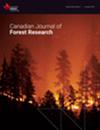用CND方法评估巴西南部桉树人工林的营养状况
IF 1.5
3区 农林科学
Q2 FORESTRY
引用次数: 0
摘要
桉树属可以生长在世界各地不同的土壤,尽管它并不总是准备好满足植物的营养需求。当出现养分短缺时,需要补缺养分,可根据叶片中养分的临界水平和充足范围(SRs)或成分营养诊断(CND)等多变量数学模型来确定。本研究旨在利用CND方法调查巴西桉树人工林的营养状况。在巴西南部的南大州(RS),对119个12月龄的盐柳桉(E. saligna)人工林进行了取样。测定叶片养分浓度和胸高直径。通过CND法计算盐芽孢杆菌的营养状况。高产群体和低产群体以胸径4.2 cm为基准设定。CND方法提出的推荐推荐量比桉树的推荐推荐量窄,特别是镁(Mg)、硼(B)和铁(Fe)。记录每种营养素的cd -r2指数生成了营养素的限制令。与单变量和双变量方法相比,CND方法提出的建议具有更高的准确性,有助于减少肥料的使用。本文章由计算机程序翻译,如有差异,请以英文原文为准。
Assessing the nutritional status of Southern Brazilian Eucalyptus plantations by the CND method
Genus Eucalyptus can be grown in different soils worldwide, although it is not always ready to fulfill plants’ nutrient demands. Whenever such nutrient shortage happens, it is necessary applying the nutrients missing, which can be established based on the critical levels and sufficiency ranges (SRs) of nutrients in leaves or by multivariate mathematical models, such as the composition nutrient diagnosis (CND). This study aimed to investigate the nutritional status of Eucalyptus plantations in Brazil, based on the CND method. A total of 119 12-month-old Eucalyptus saligna (E. saligna) plantations were sampled in the Rio Grande do Sul State (RS), Southern Brazil. Nutrient concentration in leaves and the diameter at breast height (DBH) was measured. The E. saligna nutritional status was calculated through the CND method. High- and low-yield populations were set based on DBH of 4.2 cm. The SRs proposed by the CND method were narrower than the ones proposed by official recommendations for Eucalyptus, especially for magnesium (Mg), boron (B), and iron (Fe). The CND-r2 index recorded for each nutrient generated a limitation order for nutrients. The greater accuracy of the recommendations proposed by the CND method, compared with univariate and bivariate methods, contribute to reducing the use of fertilizers.
求助全文
通过发布文献求助,成功后即可免费获取论文全文。
去求助
来源期刊
CiteScore
4.20
自引率
9.10%
发文量
109
审稿时长
3 months
期刊介绍:
Published since 1971, the Canadian Journal of Forest Research is a monthly journal that features articles, reviews, notes and concept papers on a broad spectrum of forest sciences, including biometrics, conservation, disturbances, ecology, economics, entomology, genetics, hydrology, management, nutrient cycling, pathology, physiology, remote sensing, silviculture, social sciences, soils, stand dynamics, and wood science, all in relation to the understanding or management of ecosystem services. It also publishes special issues dedicated to a topic of current interest.

 求助内容:
求助内容: 应助结果提醒方式:
应助结果提醒方式:


